September 24, 2010
By Paul Wait
Let the Migration Begin: Duck numbers steady, geese rebound
By Paul Wait, P.J. Reilly
| FLYWAY FORECASTS |
|---|
| Select from the options below for specific flyway information |
|---|
| PACIFIC | CENTRAL | MISSISSIPPI | ATLANTIC |
|---|
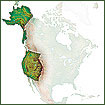 | 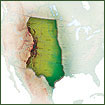 | 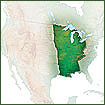 | 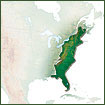 |
What a difference a couple of wet springs can make.
Advertisement
Just a few seasons ago, pintails were under a strict bag limit of one a day, and even then, shooting them was only allowed for part of the season. In 2008, canvasbacks were not allowed to be taken anywhere except for the Central Flyway, and bluebill bag limits had shrunk to one bird daily for portions of the season in the Mississippi Flyway.
Now, even though the 2010 spring breeding surveys of duck production areas in the United States and Canada showed a slight decrease to just under 41 million ducks, the results are strong enough for the U.S. Fish and Wildlife Service to recommend liberal season frameworks in all four flyways.
Advertisement
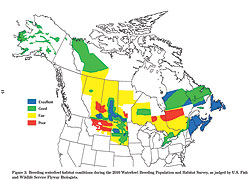 Breeding waterfowl habitat conditions during the 2010 Waterfowl Breeding Population and Habitat Survey, as judged by the U.S. Fish and Wildlife Service flyway biologists. TO ENLARGE THIS IMAGE, PLEASE CLICK HERE |
Duck hunters will have 60 days in the Atlantic and Mississippi flyways, 74 days in the Central Flyway and 107 days in the Pacific Flyway. Hunters in the Pacific Flyway will again enjoy a seven-duck daily limit, and the bag limit in the other three flyways is six ducks daily.
Buoyed by a 9 percent population increase to 3.5 million pintails in the spring breeding survey as well as a change in management strategy, waterfowlers will be afforded two sprig daily in all four flyways this season. Mallards held steady at 8.4 million, and gadwalls and green-winged teal checked in well above long-term averages.
The canvasback survey number slipped, but enough to close the season. Hunters across the United States can legally shoot a trophy canvasback every day of the season. Bluebill and redhead populations warrant liberal limits, too, despite concerns diving ducks might suffer added mortality on wintering grounds in the Gulf Coast because of the oil spill.
As positive as the duck outlook is for 2010, goose hunters also have reason to salivate in their pit blinds. Following a disappointing year for production in several key populations of Canada geese, whitefronts and snow geese, the nesting effort this spring dramatically improved.
The Arctic and most of the north had an early spring, which provided more time to nest. As a result, hunters will not only encounter more geese this season, but the flocks should contain a much-higher percentage of young birds.
Following is a more detailed look at hunting prospects for the 2010-2011 season in each flyway.
Atlantic flyway forecast is on page 2
ATLANTIC FLYWAYGary Costanzo is excited for Atlantic Flyway waterfowlers this season.
"Overall, nesting conditions were good this spring, production was good and there should be a good flight of ducks and geese this fall," said Costanzo, a migratory game bird and wetlands biologist with the Virginia Department of Game and Inland Fisheries.
Boreal forests in the eastern survey area experienced an early spring, which allowed ducks such as mallards, American wigeon, green-winged teal, bluebills and ringnecks to begin nesting earlier -- a benefit to production. Much of southern Quebec and Ontario was considered poor to fair for nesting due to dry conditions, except for west-central Ontario, where moisture was adequate. Winter precipitation from southwestern Ontario along the St. Lawrence River Valley into Maine was below average, but the waterfowl habitat was considered excellent, as it was in 2009.
| ATLANTIC FLYWAY |
|---|
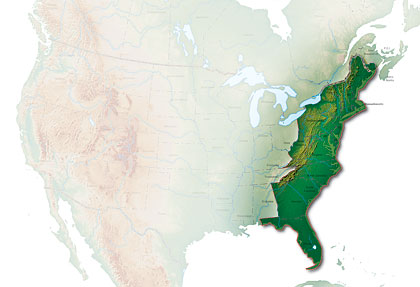 |
| General Outlook: Mallards and black ducks about as plentiful as last year. Wood ducks increased. Atlantic Population Canada geese and greater snow geese down, but production this spring was good. Season Framework: For ducks, 60 days between Sept. 25 and Jan. 30, 2011. Six ducks total, with no more than 4 mallards (2 hens), 3 wood ducks, 2 redheads, 2 hooded mergansers, 2 pintails, 2 scaup, 1 black duck, 1 canvasback, 1 mottled duck, 1 fulvous whistling duck and 4 scoters. No open harlequin season. For light geese, 107 days between Oct. 1 and March 10, 2011, as set by each individual state. Daily bag limit of 25. Canada goose season length varies. Daily bag limit of 5 in zones established for resident populations of Canada geese. Daily bag limit of 3 or fewer in zones established for migrant populations. Atlantic brant season length can be 50 days. Daily bag limit of 2. Key Changes: Daily bag limit on pintails increased to 2. Daily bag limit on light geese during the regular season increased to 25. |


In the northeast United States, there was plenty of winter snow, followed by adequate spring rains and warm weather. Combine those conditions with a 2 percent increase in the breeding duck population over 2009, and it was a good nesting year in this region. The total duck population here was estimated at 1.3 million for 2010, up from the estimated 1.2 million last year.
Mallard numbers in the flyway are expected to be similar to last year, but they've been trending down over the past decade. Kevin Jacobs, waterfowl biologist for the Pennsylvania Game Commission, said that's not necessarily due to any trouble with the population. He said it's more likely a sign of good times for duck hunters in recent years.
"We've been experiencing the most liberal seasons for ducks over the past 10 years that we've ever seen, so we've been spoiled," he said.
Mallards lead the duck harvest each year in the Atlantic Flyway.
Black ducks continue to be a species of concern. The 2010 midwinter survey turned up 203,000 blacks, which was similar to the 2009 count but 5 percent below the flyway's 10-year average from 2000-2009.
"Black ducks are kind of holding on in the short term," Costanzo said. "Their numbers went down a little bit this year, but not significantly."
Wood ducks had another good year, thanks to the wet spring and warm weather early on in the season across much of their nesting range. The 2010 population estimate of 388,300 for northeast states from New Hampshire to Virginia is statistically similar to the 2009 estimate of 386,000 and slightly higher than the long-term average of 376,000 from 1993-2009. The breeding population of wood ducks has increased about 3 percent every year over the past decade, according to the North American Breeding Bird Survey.
"Wood ducks are one of the real bright spots in the Atlantic Flyway," Jacobs said. "They're doing really well, which is good for waterfowlers, since wood ducks are the second-most common bird in our harvest each year."
In accordance with a new harvest strategy for pintails, the 2010 season framework for the Atlantic Flyway includes an increase in the daily bag limit from one bird to two. The total pintail population of 3.5 million is statistically similar to last year's and 13 percent below the long-term average of 4 million, but, according to the new management formula adopted within the past year, the current population warrants a two-bird daily bag limit. The Atlantic Flyway's pintails are produced in the Prairie Pothole Region of the United States, where nesting conditions this spring were good -- but not great -- and clutch sizes were average.
Resident Canada geese, which nest throughout the flyway, continue to hold their own at about 969,000 birds, which is similar to the 2009 estimate. Aided by the spring weather, these birds had an excellent nesting season, and production was considered above average.
Atlantic Population Canada geese, which stick to the eastern part of the flyway, have waterfowl managers poised to make a change. After a poor nesting season in 2009, conditions for the geese in Quebec were ideal this year, and production of juvenile birds was good. But the breeding population estimate of 154,000 pairs was down 13 percent from 2009, and the overall population estimate was off by 30 percent.
Costanzo said waterfowl managers this summer talked about trimming the season and/or bag limit for Atlantic Population geese for this year, but held off.
"We'll watch their numbers closely this year, but it was decided not to make a change in the season framework," Costanzo said. "Next year could be different."
For Southern James Bay Population Canadas, which migrate through the western part of the flyway, wildlife managers estimated a breeding population of 76,400 -- a 10 percent jump from 2009. The total population estimate of 87,300 is 13 percent higher than 2009.
But the nesting season wasn't great for this population in 2010, partly due to high predation by polar bears on Akimiski Island. Despite that, a better flight is expected this fall as compared to the 2009 migration, which followed an especially poor nesting effort.
Atlantic Flyway snow goose hunters, who endured a tough 2009 season that saw few juvenile birds in the population, are in for a treat this year. Although the total population estimates for the mid-continent population of lesser snow geese and for the greater snow geese -- which both send birds through the flyway -- were down from 2009, the nesting effort this spring was considered excellent. A much better fall flight than last year is expected.
"We should be happy the snow goose populations are down, since that's what we're trying to accomplish with the conservation seasons," Costanzo said. "But this should be a good year for snow goose hunters, with all of the juvies expected in the migration."
Snow geese are doing so well in the flyway, the framework for the 2010 season includes an increase in the daily bag limit for snows during the regular season from last year's 15 birds to 25 this year.
Mississippi Flyway forecast is on page 3
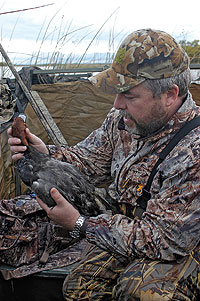 Redhead numbers remain near record-high levels. |
MISSISSIPPI FLYWAY
The oil spill in the Gulf of Mexico not withstanding, duck and goose hunters -- especially farther down the flyway -- could be in for an outstanding season.
While duck production is down in states at the top of the flyway, an influx of ducks from North Dakota and the Prairie Pothole Region of Canada should more than make up for fewer birds flying south from the Great Lakes Region.
"We are fortunate in Arkansas to get ducks in from a lot of places," said Luke Naylor, waterfowl program coordinator for the Arkansas Fish and Game Commission. "The way the colors shifted on the map this year, it looks pretty good for mallards in Arkansas this year."
And those mallards, gadwalls, teal and other ducks should find suitable wintering conditions this year.
"It has been extremely wet the past several summers, but we haven't had that this year," Naylor explained. "Several of our waterfowl manageme
nt areas had water early, but now have been dry enough for us to do management work to provide better food resources this year. Putting better habitat on the ground should hold more ducks. That's what we're hoping, anyway."
Drier conditions could also allow rice farmers to harvest the crop early and plant a second crop this year. Harvests of second-crop rice would provide a bounty of fresh duck food for migrating waterfowl, which should encourage more birds to stick around.
| MISSISSIPPI FLYWAY |
|---|
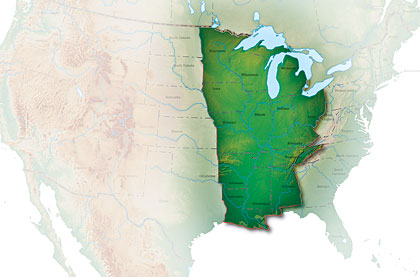 |
| General Outlook: Although drought hurt duck production in Wisconsin and Minnesota, other production areas that feed the flyway should compensate. A strong mallard flight is expected for Illinois, Arkansas and Missouri. Southern states should benefit from abundant teal, gadwall, wigeon and pintail production in the Prairie Pothole Region. Canada geese had a much better spring nesting effort than 2009, so goose hunters in northern states could have an excellent year if the weather cooperates. Season Framework: For ducks, 60 days between Sept. 25 and Jan. 30, 2011, as set by each individual state. Bag limit of 6 ducks daily, with up to 4 mallards (2 hens), 3 wood ducks, 2 redheads, 2 scaup, 2 pintails, 1 black duck, 1 canvasback and 1 mottled duck. For Canada geese, seasons generally between Sept. 25 and Jan. 30, 2011, with season lengths set by each state. Limit varies from 1 to 3 daily. For light geese, 107 days between Sept. 25 and March 10, 2011, with daily bag limit of 20. For white-fronted geese, season not to exceed 72 days with a 2-bird limit or 86 days with a 1-bird limit between Sept. 25 and Feb. 15, 2011. Key Change: Bag limit on pintails increases to 2 daily. |

 |

Although Mississippi River water levels have been extremely high much of the summer, planted food crops for ducks along key corridors such as the Illinois River are generally in much better shape than last season. Barring fall floods again this year, river hunters should encounter more ducks and more predictable hunting.
On the heels of drought conditions in the Great Lakes Region, duck survey numbers in the production states of the flyway fell this year. Wisconsin breeding duck numbers declined 23 percent to 386,501, which is 12 percent below the long-term mean.
"This spring, it was dry in Wisconsin, the Upper Peninsula of Michigan and a good chunk of Minnesota," said Kent Van Horn, migratory game bird ecologist for the Wisconsin Department of Natural Resources. "The big drop in duck numbers was in blue-winged teal in both Wisconsin and Minnesota."
Bluewings suffered the most dramatic decline of the 10 key ducks in the 2010 breeding survey, but at a spring population of 6.33 million, they still rank as the second-most abundant duck in North America. Van Horn said many bluewings that might have otherwise nested in Wisconsin and Minnesota likely shifted west to the Dakotas, where water conditions are outstanding this year.
Mallards and wood ducks were down slightly in the spring surveys, but Van Horn expects average production for 2010. Locally raised ducks are important because they comprise a high percentage of the ducks killed in northern-tier states.
"We got rain after the ducks came to nest, so wood ducks and mallards should be fine," he said.
If the weather cooperates, big-water hunters in the Mississippi Flyway should see strong diver flights. Redheads remained at near-record numbers in the spring survey, while bluebills are slightly higher in 2010 after posting a healthy increase in 2009. Canvasbacks are down a bit to 585,000, but the breeding survey seems to have a high variability for cans. Reports from North Dakota and Manitoba indicate diving ducks had good to excellent recruitment, which should equate to more ducks on pools of the Mississippi River and the Great Lakes, as well as in traditional diver haunts across the Upper Midwest.
But for hunters in the northern reaches of the flyway, the outlook for Canada geese might be the coming season's shining star.
Last season was poor for breeding geese. A late spring, followed by June storms, wiped out much of the breeding effort. However, this year, geese encountered a dramatically different landscape when they migrated north.
"Across almost all of the northern nesting areas for geese, it was an early spring, which normally bodes well for production," Van Horn said.
However, the Mississippi Valley Population of Canada geese experienced high nest predation rates from gulls on coastal regions in Hudson Bay. Still, Canada goose production is much better than last year, and about average overall.
Giant Canada geese -- the resident subspecies that has become so prolific from Minnesota to Ohio -- fared very well as a result of an early spring across the Upper Midwest, so hunters should find plenty of honkers during special September early seasons. For example, the Wisconsin breeding Canada goose population was up 12 percent to 165,853.
Similarly, snow geese had good nesting success, so light goose flocks should contain a much-higher percentage of younger birds this fall and next spring. White-fronted geese, also known as specklebellies, rebounded on the breeding grounds this spring. A good flight is expected.
The only bag limit change this season involves pintails, which many hunters in the flyway rarely encounter. Hunters can now shoot two pintails daily, up from one daily last season.
Very few pintails nest in the Mississippi Flyway, but significant numbers of sprig cross over from the Central Flyway and are an important species to hunters in Louisiana, Mississippi and, to a lesser degree, Arkansas.
"Just the idea of being able to take two pintails will excite some hunters," Naylor said. "We get good numbers of pintails in south Arkansas early and late in the season. I'm sure some folks will take full advantage of it."
Central Flyway forecast is on page 4
CENTRAL FLYWAY
If you are a resident waterfowl hunter in North Dakota, take notice: It doesn't get much better than this.
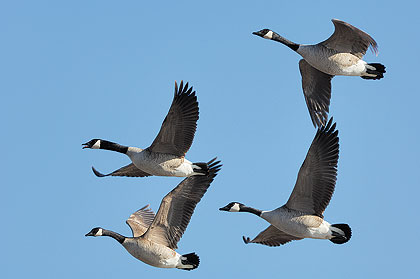 An early spring across the Upper Midwest means an abundance of giant Canada geese. |
After an extremely wet spring in 2009 that produced outstanding numbers of ducks, conditions improved even more for 2010. The result is an estimated 4.5 million breeding ducks in the state this spring, a 12 percent increase over 2009, and a whopping 107 percent above the long-term average. The breeding population in North Dakota is the third highest on record since 1948.
"Everything waterfowl-related in North Dakota is optimal," said Mike Szymanski, migratory game bird biologist for the North Dakota Game and Fish Department. "We've had sustained moisture throughout the summer and real good nesting cover despite losses in Conservation Reserve Program land."
Pintails increased 10 percent in North Dakota and are sitting at the highest level since 1970. Mallards jumped 12 percent and settled in at the fourth-highest level in the history of the North Dakota survey. Green-winged teal skyrocketed 91 percent. Among puddle ducks, only wigeon declined in North Dakota, coming in 9 percent below 2009 numbers.
Similarly, diving ducks are doing quite well, with a lot of emergent vegetation to provide nesting cover because of abundant water. Bluebills were up 54 percent, while redheads increased by 33 percent.
"We have record numbers of bluebills reproducing in North Dakota," Szymanski said. "I know ruddy ducks aren't a major species of interest for hunters, but we have record numbers of them (a 162 percent increase). Really, all of the diving ducks have done well."
While North Dakota waterfowl enjoyed super nesting conditions, ducks returning to breed in parts of Saskatchewan and Manitoba found a drier-than-normal landscape. However, late-spring and summer rains have recharged a lot of wetlands, so ducks that flew past the Dakotas this spring generally enjoyed good brood-rearing success.
"The prairies have had tremendous summer rains in Canada," Szymanski said. "It'll be wet this fall."
| CENTRAL FLYWAY |
|---|
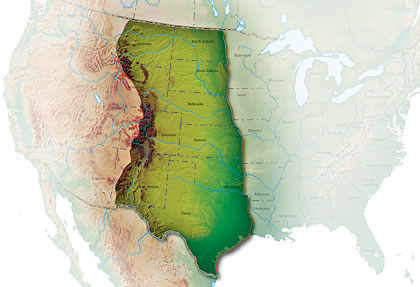 |
| General Outlook: North Dakota counted 4.5 million ducks in the state's spring breeding survey, the fourth-highest number on record. Pintails increased again, and mallard numbers are strong. Late-spring rains in prairie Canada improved brood-rearing conditions and should mean more ducks this fall. Goose nesting efforts were strong. If weather cooperates, hunters throughout the flyway should enjoy excellent waterfowling. Season Framework: For ducks, 74 days (97 days in the High Plains Mallard Unit) between Sept. 25 and Jan. 30, 2011, as set by each individual state. Bag limit of 6 ducks daily, with up to 5 mallards (2 hens), 3 wood ducks, 2 redheads, 2 scaup, 2 pintails, 1 canvasback and 1 mottled duck. Mottled duck season in Texas closed first 5 days of season. For Canada geese in the East Tier, 107-day season between Sept. 25 and Feb. 13, 2011, with a daily bag limit of 3. For white-fronted geese, season not to exceed 72 days with a 2-bird limit or 86 days with a 1-bird limit. In the West Tier, states can select 107-day season for dark geese, with a daily bag limit of 5. For light geese, 107 days between Sept. 25 and March 10, 2011, with daily bag limit of 20. Key Change: Bag limit on pintails increases to 2 daily. |

 |

The boon in North Dakota should spread down the flyway and benefit hunters in states directly to the south such as Nebraska, Kansas, Oklahoma and Texas.
"When the birds settle that far south to nest, they don't move east and west as much when they migrate south," said Dave Morrison, waterfowl program leader for the Texas Parks and Wildlife Department. "Look at what happened last year. Harvest was down in all of the other flyways, but stayed steady in the Central Flyway."
With continental mallard breeding numbers holding steady at 8.4 million this spring, hunters in the heart of the United States can expect plenty of greenheads over the decoys again. Whether the ideal scenario of flooded crops and winter weather plays out as it did in South Dakota last fall remains to be seen.
However, more flocks of migrating pintails are guaranteed. Breeding pintail numbers rose continentally to 3.5 million, more than half of which nest in the Prairie Pothole Region. After several seasons of restrictive bag limits, the U.S. Fish and Wildlife Service has authorized a two-bird daily limit for pintails this season as part of a new management strategy for the species.
Hunters at the top of the flyway are certainly pleased about the prospect of taking two pintails, but nowhere is a second sprig more important than on the Texas Gulf Coast.
"Hunters are going to be happy," Morrison said. "Pintails are important ducks to a lot of Texas waterfowl hunters."
Ducks and geese that make it to Texas should find favorable wintering grounds this year.
"We received some timely rains, so there will be a lot of areas for ducks," Morrison said. "Conditions are better than they have been the past few years. I don't have a crystal ball, but Central Flyway duck hunters should do fairly well. How we do in Texas depends on the weather fronts."
Goose hunters have just as much reason for optimism. Canada geese nesting in the Arctic -- generally the smaller subspecies -- were able to lay eggs earlier than last year because of early ice-out, and no significant weather events wiped out broods. All the water in the Dakotas encouraged banner production of resident giant Canada geese, too.
"We have too many," Szymanski said.
The mid-continent population of white-fronted geese, across central Arctic and interior Alaska, migrate through Saskatchewan and down the Central Flyway to Texas and Mexico. The fall 2009 survey in Saskatchewan and Alberta estimated the population at 583,200, a 22 percent decline. Gosling production this spring in Alaska appeared to be excellent, which should boost the fall flight. An average year is expected.
Snow geese remain above population goals and continue to provide hunters throughout the flyway with long seasons and liberal bag limits. Although it will put added stress on the arctic breeding grounds, goose hunters will be happy to hear snows had a good nesting cycle in 2010 after dismal production last year.
"Anything compared to last year is going to be
good," Morrison said. "Last year was a total bust in terms of production. I think there will be more young birds in the flocks. It's going to be a better season."
Pacific Flyway forecast on page 5
PACIFIC FLYWAY
Highlighting the list of conditions Pacific Flyway ducks and geese found on their nesting grounds this past spring was the total absence of ice in northern Alberta, British Columbia and the Northwest Territories -- a stark contrast to 2009, when ice hung around in some areas until July.
"Winter precipitation was a bit low in northern Canada, but with no ice on the breeding grounds, birds were able to start nesting early," said Don Kraege, waterfowl section manager for the Washington Department of Fish and Wildlife. "If they can get on their nests early, that usually offsets other negative habitat conditions."
The total duck estimate for central and northern Alberta, northeastern British Columbia and the Northwest Territories was 26 percent higher in spring 2010 than it was in 2009 and 23 percent higher than the long-term average. In southern Alberta, conditions remained dry, and production was down. Likewise, the nesting effort was off in the western Dakotas and eastern Montana, where total duck numbers dropped 20 percent below the 2009 estimate.
In the Alaska, Yukon Territory and Old Crow Flats Region, nesting conditions were excellent. Precipitation was normal, and spring came early. As a result, the total duck estimate for that area in spring 2010 was up 28 percent from 2009 and stood 52 percent above the long-term average.
| PACIFIC FLYWAY |
|---|
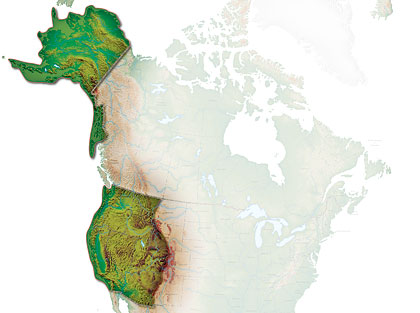 |
| General Outlook: Mallards and wigeon are up slightly. Green-winged teal numbers up significantly in the western half of the flyway. Large flight of white-fronted geese expected. Numbers up for small Canada geese. Poor production for snow geese in some nesting areas. Season Framework: For ducks, 107 days (86 for scaup) between Sept. 25 and Jan. 30, 2011, as set by each individual state. Seven ducks total, with no more than 3 scaup, 2 hen mallards, 2 redheads, 2 pintails and 1 canvasback. For geese, 107-day seasons between Sept. 25 and March 10, 2011, bag limit up to 10 light geese and 4 dark geese. There are exceptions to the basic bag limits and season structures for geese in many states, so consult state regulations for specific details. In California, Washington and Oregon, the dark goose limit does not include brant. Brant, 16 days in Oregon and Washington, and 30 days in California, 2-bird daily limit |

 |

"Hunters in the western part of the flyway should see some great duck numbers this fall because of the nesting conditions in Alaska," said Dan Yparraguirre, waterfowl coordinator for the California Department of Fish and Game.
In that coastal area, mallards, pintails, green-winged teal and wigeon are the ducks most commonly found in hunters' bags. Mallards showed population gains this spring over last year in most of the Pacific Flyway survey areas. Wigeon counts were up and down, for an overall drop of about 2 percent from 2009. Pintail numbers were similar to last year's and about 13 percent below the long-term average.
Green-winged teal numbers were similar this year to 2009 estimates, but in the western half of the flyway, hunters should see a much better flight this year than they did in 2009. The count this past spring in the Alaska, Yukon Territory and Old Crow Flats Region jumped 45 percent over the 2009 figure.
"Any losses in numbers we might see in the eastern half of the flyway because of the poor habitat in southern Alberta and eastern Montana should be offset by local duck production," Yparraguirre said. "Some of the states in the Pacific Flyway had pretty good nesting conditions this spring."
Decent spring rains in California's Central Valley, for example, allowed depressions in the vast wheat fields to fill with water, providing prime nesting habitat for mallards and other ducks right smack in the middle of the dinner table, according to Yparraguirre. Total duck counts this spring were up 6 percent in California and 11 percent in Oregon over the 2009 figures, while slight declines were seen in duck numbers in Nevada and Washington.
"Generally speaking, goose hunters should have a pretty good season this year in the Pacific Flyway," Kraege said. "Even for the populations where the spring estimates were down, the production was pretty good for most of the different species, and there should be a lot of juveniles in the flight this fall."
The Pacific Population of white-fronted geese, which winter in California's Central Valley, increased their numbers for 2010 to 649,800 -- a 21 percent spike over 2009. Biologists expect good production and a better-than-normal fall flight.
"We're going to be up to our ears in white-fronts," Yparraguirre said.
Mid-Continent Population white-fronts, which stick to the eastern portion of the flyway, did not fare as well as the Pacific geese. Their numbers were down this spring 22 percent from 2009. In areas such as interior Alaska, birds encountered good nesting conditions, while in areas such as Queen Maud Gulf, they were hampered by nasty weather. Overall, production for these birds is expected to be average.
The Rocky Mountain Population of Canada geese increased their numbers to 148,900, which is 15 percent higher than in 2009. The counts were up from last year in Alberta, Montana, Wyoming and Colorado, while they dipped in Idaho, Utah, Nevada and Arizona. The fall flight is expected to be average.
Cold, wet spring weather is believed to have hampered gosling production in the Pacific Population of Canadas, which nest and winter west of the Rocky Mountains. The 2010 nesting effort was up in Alberta and Idaho, but declined in all other areas from 2009. A fall flight similar to 2009 is expected this year, although there will be fewer juveniles in the flock.
Dusky, lesser and Taverner's, cackling and Aleutian Canada geese all had decent nesting seasons in 2010, and average fall flights a little better than last year's are forecast.
Ross's geese that nest in the Queen Maud Gulf Region and migrate to parts of California for the winter had a tough year, due to harsh conditions on the breeding grounds. Same goes for Wrangel Island Population snow geese that sail through Oregon, Washington and California. While the overall number of birds should be sim
ilar to last year, poor production should result in lower numbers of juveniles in the flight this fall for both.
Pacific brant experienced average nesting conditions across Alaska's Yukon-Kuskokwim Delta. Snowpack was sparse, while spring temperatures were cool and ice-socked in the Yukon River later than normal. Reports indicated a strong nesting effort, even though clutch sizes were down slightly. A fall flight similar to last year's is predicted.
| OIL SPILL WON'T AFFECT SEASON'S BAG LIMITS |
|---|
Waterfowlers concerned with how the Gulf Coast oil spill will affect the coming season can polish their shotguns for business as usual. The U.S. Fish and Wildlife Service announced it is not reducing bag limits this season because migrating ducks might encounter oiled waters.Paul Schmidt, assistant director for migratory birds for the USFWS, said the Service would rely on adaptive harvest management to determine if lower limits are needed for species such as bluebills and redheads in the future. Hundreds of thousands of diving ducks rely on offshore areas of the Gulf for wintering habitat. "We do not feel that immediate harvest restrictions are warranted at this current time," Schmidt said on July 2. "We're going to continue to monitor it, and if there seems to be impacts that surprise us in terms of population level effects, then we would be prepared to address that in a subsequent harvest management decision. "But I think right now we feel very comfortable with the system in place. I don't want to trivialize this, but this is a mortality event for us that we're going to consider as a disease outbreak or a hurricane effect or some other disaster that would have an impact. Our system (adaptive harvest management) is in place to make those adjustments in future cycles." Meanwhile, the National Fish and Wildlife Foundation is making strides to provide birds relying on Gulf Coast habitats with safe, oil-free environments. Through a $2.5 million grant to Ducks Unlimited, the NFWF is setting aside at least 20,000 acres of wetlands untainted by oil near the Gulf Coast, including coastal Louisiana and Texas -- areas essential for migration and wintering territory. This measure will attract ducks and geese inland and away from the oiled areas. Although Schmidt said providing additional inland wintering habitat will not likely change major migration patterns, the additional wetlands could significantly affect local populations. The grant will pay for forming the new alternative habitat through crop planting, field-flooding, burning and removing invasive plants. "These measures are designed to minimize the entrance of oil into the managed habitats along the Gulf and enhance the availability of migratory bird food resources outside the oil-impacted area," Schmidt said. -- Angela Pham |
